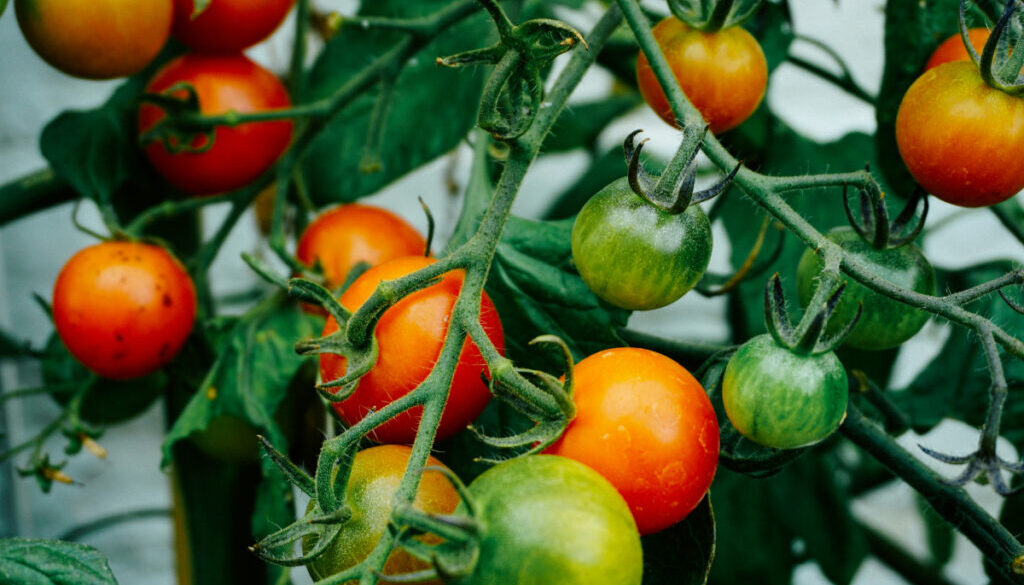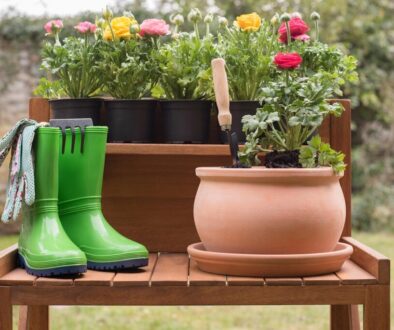5 Easy-to-Grow Plants That Make Gardening Worth It
Tomatoes: The Homerown Favorite: Why Fresh Tomatoes Beat Store-Bought Every Time
If you’ve ever plucked a ripe tomato off a vine in your backyard, you know the magic of gardening. That warm, juicy burst of flavor is unbeatable, making homegrown tomatoes the undisputed star of any veggie patch. But what makes these backyard gems superior to the ones from the store? Let’s dig into it (pun intended).
The Taste Test: Nature Wins Every Time
When you grow your tomatoes, the flavor difference is like night and day. Store-bought tomatoes often travel hundreds of miles before reaching your plate, picked prematurely and ripened artificially. They look nice, sure, but bite into one, and you might be met with a bland, watery disappointment. Homegrown tomatoes, on the other hand, ripen naturally on the vine, soaking up all the sun and nutrients they need to taste their best. Each bite is a delicious reward for your gardening efforts, bursting with sweetness and tang.
And let’s be honest—have you ever cut into a store-bought tomato and be amazed? Probably not. But with a homegrown tomato, even the simplest salad or sandwich becomes a gourmet experience. It’s not just food; it’s art.
Gardening your tomatoes also ensures variety. Supermarkets offer a limited selection, but your garden can host an heirloom tomato festival. From tangy green zebras to juicy black cherries, the choices are endless, and each type brings its unique benefits to your plate. My favorite tomatoes to grow in my garden are Sun Sugar, Sweeties Cherry Tomatoes and Tumbler Cherry Tomatoes.
The Joy of Gardening: A Hobby That Keeps Giving
Growing your tomatoes isn’t just about the result; it’s about the journey. There’s something deeply satisfying about planting seeds, nurturing your plants, and watching them flourish. Gardening becomes more than a chore—it’s therapy, a way to connect with nature and find peace in a busy world.
And let’s not forget the bragging rights! When your neighbor stops by and marvels at your tomato crop, you can smile knowingly. “Oh, these? Just a little something from my garden.” It’s a humble flex that never gets old.
Plus, tending to your tomato plants is an excellent excuse to spend more time outside. Fresh air, sunshine, and a bit of physical activity—it’s the trifecta of feel-good moments. By the time those tomatoes are ready to harvest, you’ll feel like a proud plant parent.
The Environmental Bonus
Here’s the cherry (tomato) on top: growing your own save the planet a little, too. Think about all the energy involved in getting store-bought tomatoes to your kitchen—the trucks, the fuel, the packaging. When you grow your own, you skip all that. It’s a small step, sure, but when it comes to sustainability, every little bit helps.
Gardening also reduces food waste. With store-bought tomatoes, you might toss out a bland batch without a second thought. But when you’ve grown them yourself, you appreciate every single fruit. Even the funny-shaped ones feel like treasures because you know how much work went into growing them.
Your Homegrown Adventure Awaits
If you’ve been on the fence about starting your garden, let tomatoes be your gateway crop. They’re surprisingly easy to grow, even for beginners, and the rewards are massive. A sunny patch, a little water, and some love are all it takes to get started.
Before long, you’ll wonder why you ever settled for store-bought. Gardening isn’t just a way to grow food; it’s a way to grow joy. So grab a shovel, find some seeds, and get planting. Your taste buds—and the planet—will thank you!
Lettuce and Greens: How to Grow Salad Ingredients in Even the Smallest Spaces
Who doesn’t love the idea of stepping outside, plucking fresh greens, and tossing them straight into a bowl? Gardening may sound like a luxury reserved for those with sprawling backyards, but even if you’re working with just a windowsill or balcony, you can grow your delicious salad greens. With a pinch of creativity and a sprinkle of effort, you’ll have a mini garden brimming with lettuce and other greens in no time. Let’s dig in!
Choose Your Greens Wisely
When it comes to small-space gardening, variety is your best friend. Lettuce, Spinach, Kale, and Arugula are perfect choices because they’re fast-growing, don’t need deep soil, and thrive in small containers. You could even mix and match different types of greens for a salad that’s as colorful as it is tasty. Some varieties, like loose-leaf lettuce, can be harvested multiple times, making them a gift that keeps on giving. The variety of Lettuce I like grow is Mesclun Mix.
When you’re choosing seeds or seedlings, consider your growing conditions. Do you have a sunny windowsill? Go for sun-loving greens like Romaine. If you’re working with partial shade, Spinach or Swiss Chard might be your go-to. Remember, it’s all about working with what you have—gardening is surprisingly forgiving!
Containers: Big Taste, Small Space
Who says you need a big garden bed to grow big flavors? Containers are the magic trick for small-space gardening. You can use pots, hanging baskets, window boxes, or even upcycled items like old colanders or mason jars. Just make sure whatever you choose has good drainage, because your greens hate soggy roots as much as you hate soggy salads.
Keep in mind the size of your plants when picking a container. Lettuce doesn’t need much room to spread its roots, but a slightly bigger pot means happier, healthier greens. A shallow container, about six inches deep, is usually plenty for most salad ingredients. The bonus? You can move your containers around to chase the sun or dodge bad weather.
Soil and Water: The Secret to Happy Greens
The foundation of any successful garden—big or small—is good soil. For container gardening, go with a high-quality potting mix that retains moisture but drains well. Adding a bit of compost can boost nutrients, giving your greens a healthy start. You don’t need to be a soil scientist; just look for mixes labeled for veggies or general use, and you’re golden.
Watering is where many beginner gardeners slip up, but it’s easy once you know the trick. Salad greens like consistent moisture but don’t want to drown. Check the soil daily—if the top inch feels dry, it’s time to water. Early mornings or evenings are the best times, so the water has time to soak in without evaporating too quickly. Trust me, your plants will thank you by staying crisp and vibrant!
Harvesting: From Pot to Plate
Here’s the most exciting part of your gardening journey: harvest time! The beauty of growing Lettuce and other greens is that you don’t have to wait for the whole plant to mature. Most salad greens are “cut-and-come-again,” meaning you can snip off what you need and let the plant keep growing.
Use scissors to clip leaves a few inches above the base, and avoid cutting too much from any one plant. A little here and there will keep your greens producing longer. Plus, there’s something so satisfying about eating a salad you’ve nurtured from seed—it’s like tasting a piece of your success!
Bonus Tips for Thriving Greens
Get Creative with Vertical Gardening: If space is tight, try a vertical garden setup. Stackable planters or wall-mounted pockets can multiply your growing area without taking up extra floor space.
Companion Planting: Add a few herbs like Basil or Cilantro to your container garden. Not only will they spice up your salads, but they can also deter pests and save space.
Keep It Cool: Greens tend to bolt or go to seed, in hot weather. If you’re gardening in summer, move your containers to a cooler spot or use shade cloth to keep things fresh.
Gardening in small spaces isn’t just possible—it’s downright fun! With a little care and attention, you can turn any sunny corner into a thriving salad station. So grab some seeds, a container, and your favorite gardening gloves. Before you know it, you’ll be enjoying the freshest, tastiest salads you’ve ever had.

Herbs for Every Dish: Basil, Mint, and Rosemary Made Easy
There’s something magical about tossing fresh herbs into your cooking. Whether it’s the sweet aroma of Basil, the cool kick of Mint, or the earthy warmth of Rosemary, herbs elevate any dish from basic to brilliant. And the best part? Gardening with herbs is incredibly easy—even for beginners. You don’t need acres of land, just a little space, a few pots, and a love for fresh flavors. Let’s dive into the wonderful world of herb gardening!
Basil: The Star of Italian Nights
Basil is the ultimate crowd-pleaser in the herb world. Its vibrant green leaves and peppery-sweet flavor make it a must-have for everything from pesto to pizza. Growing Basil is as easy as sprinkling seeds, adding water, and watching it thrive. This sun-loving herb is happiest in warm conditions, so pick a sunny windowsill or a spot on your balcony for the best results.
You’ll want to plant Basil in a pot with good drainage—because soggy roots are a no-no. A six-inch-deep container is perfect. The secret to lush, bushy Basil? Frequent harvesting! Pinch off the top leaves regularly, and your plant will grow fuller, ensuring a steady supply of fresh goodness for weeks.
Basil also loves a little TLC in the form of regular watering. Keep the soil moist but not soaked, and your Basil will repay you with a fragrant kitchen companion. Just imagine the joy of whipping up a Caprese salad with Basil you’ve grown yourself—it’s next-level satisfying!
Mint: The Fresh-Flavor Machine
Mint is the life of the herb garden party. From Mojitos to Mint tea and even garnishes for desserts, this herb is endlessly versatile. But fair warning: Mint has a reputation for being a bit of a garden bully. Its roots spread like wildfire, so keeping it in its container is a smart move.
Mint thrives in partial sun, so it’s perfect for spots that don’t get blazing sunlight all day. A medium-sized pot is all you need, and it’ll grow like a champ. Water it consistently, but don’t overdo it—Mint appreciates moisture but dislikes swampy conditions.
One of the best things about Mint is its resilience. Forget to water it for a few days? It’ll forgive you. Accidentally snip off too much? It’ll bounce back. If you’re looking for a low-maintenance herb with high rewards, Mint has your back. Plus, having Mint on hand means impromptu cocktails, and refreshing summer drinks are always an option.
Rosemary: The Fragrant Workhorse
If you’re dreaming of roasting potatoes with fragrant Rosemary or adding a savory twist to soups, this hardy herb is for you. Rosemary is one of the easiest herbs to grow, even if you’re new to gardening. Its needle-like leaves pack a flavor punch, and its woody stems make it a sturdy addition to any garden.
Rosemary loves the sun, so give it a bright spot with at least six hours of sunlight daily. A slightly larger container works best since rosemary likes to spread its roots a bit. The key to happy rosemary is well-draining soil—this herb comes from the Mediterranean, so it’s used to drier conditions. Overwatering is its kryptonite.
Once your Rosemary is growing strong, you’ll love how versatile it is. Use it fresh, dry it for long-term storage, or even tie a sprig to a gift for a fragrant touch. And don’t forget, Rosemary plants look as good as they taste, with their silvery-green leaves adding a touch of elegance to your garden.
Tips for Thriving Herbs
Keep It Snippy: Regularly trimming your herbs not only keeps them neat but also encourages new growth. Plus, you’ll always have fresh herbs on hand.
Feed Them Right: Herbs aren’t too needy, but a little liquid fertilizer once a month can keep them thriving. Look for one suited for edibles.
Companion Planting: If you have space, consider grouping herbs with similar needs together. Basil and Rosemary, for example, love sunshine, making them perfect neighbors.
Bring Them Indoors in Winter: Herbs like Basil are sensitive to cold, so if temperatures drop, move them indoors near a sunny window.
Growing your herbs is about more than just convenience—it’s a little bit of magic in your daily life. Whether you’re a culinary enthusiast or just enjoy a touch of green in your home, herbs like Basil, Mint, and Rosemary will never let you down. So grab some seeds or seedlings, find a sunny spot, and let the herb gardening adventure begin. Your taste buds will thank you!

Zucchini and Squash: High-Yield Veggies That Keep on Giving
If you’re looking for vegetables that grow fast, produce plenty, and are super versatile in the kitchen, zucchini and squash are your best friends. These prolific plants are the overachievers of the gardening world, rewarding even novice gardeners with more veggies than they know what to do with. Ready to add these high-yield champs to your garden? Let’s dive in!
Why Zucchini and Squash are Gardening Gold
Zucchini and Squash are perfect for gardeners who love a big payoff. Once these plants get going, they don’t stop. One or two plants can supply you with enough veggies to share with neighbors, freeze for later, and still have plenty for every recipe you can imagine.
Both Zucchini and Squash thrive in warm weather and love soaking up the sun. These veggies are great for gardeners with a little space to spare, as they grow quickly and spread out. But don’t worry if your garden is compact—bush varieties take up less room and are just as productive.

The best part? Zucchini and Squash are beginner-friendly. If you can provide sunlight, good soil, and regular watering, you’re well on your way to a bumper crop. And trust me, there’s no better feeling than slicing into a Zucchini you grew yourself!
Planting: Set the Stage for Success
Getting started with Zucchini and Squash is simple. These plants love warm soil, so wait until the weather has warmed up before planting. If you’re starting from seeds, plant them directly in the garden or a large container with at least 12 inches of depth. Spacing is key—give each plant enough room to spread out, about two to three feet apart.
If patience isn’t your thing, you can use seedlings to speed things up. Just dig a hole, plant the seedling, and watch it take off. For container gardening, choose pots that are at least 18 inches wide to give the roots room to grow. Add a trellis or stakes for vining varieties to save space and keep your veggies off the ground.
Care Tips: Keep Your Plants Happy
Zucchini and Squash may be easygoing, but a little extra care goes a long way. These plants love consistent watering, so aim to keep the soil moist but not soggy. Mulching around the base can help retain moisture and keep weeds at bay.
Fertilize your plants every few weeks with a balanced fertilizer to encourage healthy growth and more veggies. Zucchini and Squash are pollinator magnets, but if you notice fewer fruits, try hand-pollinating with a small brush to transfer pollen between flowers. It’s like matchmaking for your plants!
One thing to watch out for is pests like squash bugs or powdery mildew. Check your plants regularly and remove any pests or affected leaves. With a little attention, your Zucchini and Squash will stay happy and productive all season long.
Harvest Time: The More You Pick, the More They Give
Here’s the exciting part—harvesting! Zucchini and Squash grow quickly, so keep an eye on them to pick at just the right time. For Zucchini, aim for a size of six to eight inches for the best flavor and texture. Summer Squash can be picked when they’re small and tender, about four to six inches long.
The golden rule? Don’t let them sit too long! Overripe Zucchini and Squash can become tough and lose their flavor. Plus, the more you harvest, the more the plant will produce. It’s a win-win!
If you’re overwhelmed with your harvest, get creative. Grate Zucchini for bread or muffins, slice it for stir-fries or spiralize it into low-carb noodles. Squash is equally versatile—grill it, roast it, or add it to casseroles for a comforting, homegrown meal.
Tips for a Bumper Crop
Succession Planting: Plant a second batch of seeds a few weeks after the first for an extended harvest season.
Companion Plants: Grow Zucchini and Squash alongside Marigolds or Nasturtiums to deter pests and add pops of color to your garden.
Storage Smarts: Fresh Zucchini and Squash can last for about a week in the fridge, but blanch and freeze extras to enjoy later.
Gardening Zucchini and Squash is like hitting the vegetable jackpot. They’re easy to grow, produce tons of delicious veggies, and make every meal feel special. Whether you’re a seasoned gardener or just starting, these high-yield veggies are a fantastic choice. So grab some seeds, get your hands dirty, and get ready for a summer filled with gardening success and tasty rewards!
Happy Gardening!




